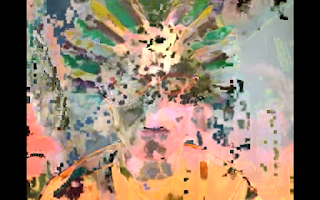When a video is encoded, each frame is stored as an I frame or a P/B frame. An I frame [Sven Konig calls them ∆-frames] is like a JPEG image, it holds the still image (that frame) in its entirety. P and B frames are the smart frames that allow videos to be compressed. They store only the differences between the current frame and the last frame. The effect you see in the datamosh videos is what happens when you store only the differences between frames, ie. when there are no I-Frame references.
Here is how you can do it the hardcore way:
1. Get your video in MPEG4 format, XViD or DIVX is fine.
2. Save it as an AVI file
3. Download a HEX editor and open the AVI file with it. (http://www.chmaas.handshake.de/delphi/freeware/xvi32/xvi32.htm is good, and free) You'll see a lot of numbers and symbols. This is the raw video data.
Each video frame in the AVI file will start with the code 00dc, you can search for these in the file (there will be a lot!). About 1 in 25 of these will be an I-Frame (though this depends on things like what quality you saved it at, etc). An I-Frame can be identified by the HEX string 00 01 B0 01 that will appear about 5 bytes after the 00dc frame start marker.
4. These are the frames you need to nuke. I think you can just hold delete until all the data is gone, and the next 00dc, or 00wb moves into its place.
Here is how you can do it the hardcore way:
1. Get your video in MPEG4 format, XViD or DIVX is fine.
2. Save it as an AVI file
3. Download a HEX editor and open the AVI file with it. (http://www.chmaas.handshake.de/delphi/freeware/xvi32/xvi32.htm is good, and free) You'll see a lot of numbers and symbols. This is the raw video data.
Each video frame in the AVI file will start with the code 00dc, you can search for these in the file (there will be a lot!). About 1 in 25 of these will be an I-Frame (though this depends on things like what quality you saved it at, etc). An I-Frame can be identified by the HEX string 00 01 B0 01 that will appear about 5 bytes after the 00dc frame start marker.
4. These are the frames you need to nuke. I think you can just hold delete until all the data is gone, and the next 00dc, or 00wb moves into its place.

Comments